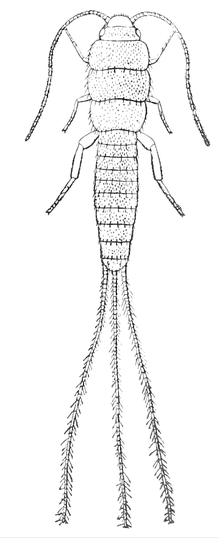Lepidotrix
Appearance
| Lepidotrix Temporal range:
| |
|---|---|

| |
| Scientific classification | |
| Domain: | Eukaryota |
| Kingdom: | Animalia |
| Phylum: | Arthropoda |
| Class: | Insecta |
| Order: | Zygentoma |
| Family: | Lepidotrichidae |
| Genus: | †Lepidotrix Menge, 1854 |
| Species: | †L. piliferum
|
| Binomial name | |
| †Lepidotrix piliferum Menge, 1854
| |
Lepidotrix is an extinct genus of wingless insect belonging to Zygentoma (silverfish and allies) in the family Lepidotrichidae. There is one described species in Lepidotrix, L. piliferum/pillifera. It is known from specimens found in Eocene aged Baltic amber and Rovno amber.[1][2][3] The genus lacks occelli. Its relationship with the extant genus Tricholepidion, which has historically been placed in the same family, is disputed, with some studies finding the two taxa to not be closely related, with Tricholepidion being placed in its own family instead.[4] While often spelled Lepidothrix in historic literature, this is homonymous with a genus of birds, and Lepidotrix was the spelling used in the original publication.[5]
References
- ^ "Lepidotrix". GBIF. Retrieved 2020-01-25.
- ^ "The Paleobiology Database, genus Lepidotrix". Retrieved 2020-01-25.
- ^ Kaplin, V. G.; Perkovsky, E. E. (September 2018). "On the Fauna of Bristletails (Zygentoma, Microcoryphia) of the Rovno Amber". Paleontological Journal. 52 (5): 541–545. doi:10.1134/S0031030118050052. ISSN 0031-0301.
- ^ Grimaldi, David A. (March 2010). "400 million years on six legs: On the origin and early evolution of Hexapoda". Arthropod Structure & Development. 39 (2–3): 191–203. doi:10.1016/j.asd.2009.10.008.
- ^ Zuccon, Dario (September 2011). "The case of Lepidothrix, Lepidotrix and Neolepidothrix: the importance of the original literature in taxonomic decisions". Zoosystematics and Evolution. 87 (2): 379–382. doi:10.1002/zoos.201100015.
